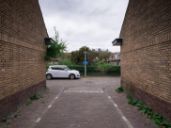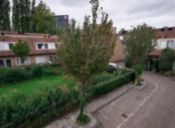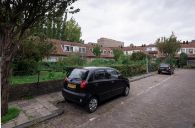The Transvaalhof in 2022
Since the recording of the video and the newspaper article, some things have changed in the Transvaalhof. The women working in doorways, the children playing in the street, and the large families are no longer the residents of the hof. A much more diverse group of people live there now, with fewer young children. Some have lived there their whole lives, while others have just moved in. The green in the middle of the hof also underwent changes since the opening in 1928. Although originally meant as a playground for children, the area was temporarily used in the meantime as a place to store trash, and now the residents are trying to prevent total overgrowth. The scaffolding temporarily placed in the hof for renovation work symbolizes the transformation and renewal the Transvaalhof has undergone over the past century.
What seems to be a given, is that behind the gates of the Transvaalhof is a little neighborhood on its own. Here we see Gladys and Bas. Gladys, who has been living in the hof for 5 years, explains that it feels like a separate world, away from the busy city. It is something unique, as it is located close to the train station and the city center, and its gates cannot be locked as they can with other similar hofjes. It might not be the close community it once was, but the residents are still connected to each other and they still exchange stories. For example, Gladys tells us that her neighbor, who has been living in the hof her entire life, still owned the rent cards of her parents from the time after the hof just had opened, with which the weekly rent was picked up. Now this all goes automatically.
Although the residents value their privacy, they do know where everybody more or less lives. This is also what the architect Buurman had envisioned when he designed the Transvaalhof in the 1920s. What did he envision exactly?



